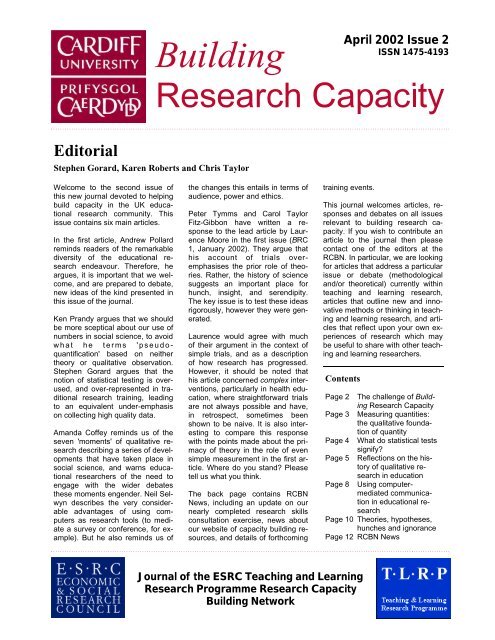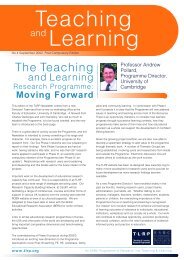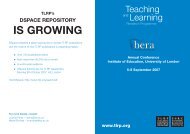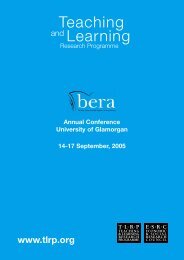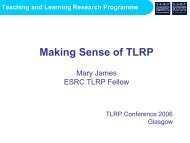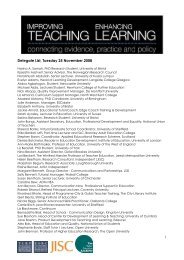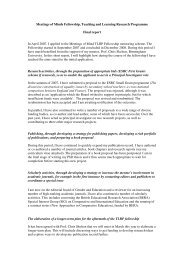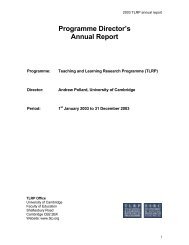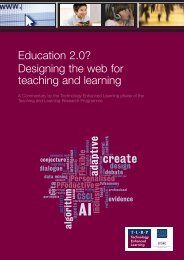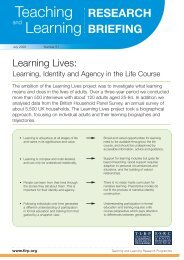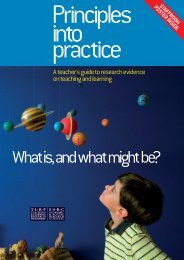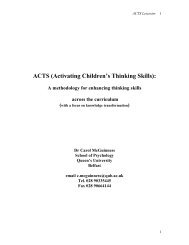Issue 2: the qualitative foundation of quantity - Teaching and ...
Issue 2: the qualitative foundation of quantity - Teaching and ...
Issue 2: the qualitative foundation of quantity - Teaching and ...
Create successful ePaper yourself
Turn your PDF publications into a flip-book with our unique Google optimized e-Paper software.
Building<br />
April 2002 <strong>Issue</strong> 2<br />
ISSN 1475-4193<br />
Editorial<br />
Stephen Gorard, Karen Roberts <strong>and</strong> Chris Taylor<br />
Welcome to <strong>the</strong> second issue <strong>of</strong><br />
this new journal devoted to helping<br />
build capacity in <strong>the</strong> UK educational<br />
research community. This<br />
issue contains six main articles.<br />
In <strong>the</strong> first article, Andrew Pollard<br />
reminds readers <strong>of</strong> <strong>the</strong> remarkable<br />
diversity <strong>of</strong> <strong>the</strong> educational research<br />
endeavour. Therefore, he<br />
argues, it is important that we welcome,<br />
<strong>and</strong> are prepared to debate,<br />
new ideas <strong>of</strong> <strong>the</strong> kind presented in<br />
this issue <strong>of</strong> <strong>the</strong> journal.<br />
Ken Pr<strong>and</strong>y argues that we should<br />
be more sceptical about our use <strong>of</strong><br />
numbers in social science, to avoid<br />
what he terms 'pseudoquantification'<br />
based on nei<strong>the</strong>r<br />
<strong>the</strong>ory or <strong>qualitative</strong> observation.<br />
Stephen Gorard argues that <strong>the</strong><br />
notion <strong>of</strong> statistical testing is overused,<br />
<strong>and</strong> over-represented in traditional<br />
research training, leading<br />
to an equivalent under-emphasis<br />
on collecting high quality data.<br />
Am<strong>and</strong>a C<strong>of</strong>fey reminds us <strong>of</strong> <strong>the</strong><br />
seven 'moments' <strong>of</strong> <strong>qualitative</strong> research<br />
describing a series <strong>of</strong> developments<br />
that have taken place in<br />
social science, <strong>and</strong> warns educational<br />
researchers <strong>of</strong> <strong>the</strong> need to<br />
engage with <strong>the</strong> wider debates<br />
<strong>the</strong>se moments engender. Neil Selwyn<br />
describes <strong>the</strong> very considerable<br />
advantages <strong>of</strong> using computers<br />
as research tools (to mediate<br />
a survey or conference, for example).<br />
But he also reminds us <strong>of</strong><br />
<strong>the</strong> changes this entails in terms <strong>of</strong><br />
audience, power <strong>and</strong> ethics.<br />
Peter Tymms <strong>and</strong> Carol Taylor<br />
Fitz-Gibbon have written a response<br />
to <strong>the</strong> lead article by Laurence<br />
Moore in <strong>the</strong> first issue (BRC<br />
1, January 2002). They argue that<br />
his account <strong>of</strong> trials overemphasises<br />
<strong>the</strong> prior role <strong>of</strong> <strong>the</strong>ories.<br />
Ra<strong>the</strong>r, <strong>the</strong> history <strong>of</strong> science<br />
suggests an important place for<br />
hunch, insight, <strong>and</strong> serendipity.<br />
The key issue is to test <strong>the</strong>se ideas<br />
rigorously, however <strong>the</strong>y were generated.<br />
Laurence would agree with much<br />
<strong>of</strong> <strong>the</strong>ir argument in <strong>the</strong> context <strong>of</strong><br />
simple trials, <strong>and</strong> as a description<br />
<strong>of</strong> how research has progressed.<br />
However, it should be noted that<br />
his article concerned complex interventions,<br />
particularly in health education,<br />
where straightforward trials<br />
are not always possible <strong>and</strong> have,<br />
in retrospect, sometimes been<br />
shown to be naive. It is also interesting<br />
to compare this response<br />
with <strong>the</strong> points made about <strong>the</strong> primacy<br />
<strong>of</strong> <strong>the</strong>ory in <strong>the</strong> role <strong>of</strong> even<br />
simple measurement in <strong>the</strong> first article.<br />
Where do you st<strong>and</strong>? Please<br />
tell us what you think.<br />
The back page contains RCBN<br />
News, including an update on our<br />
nearly completed research skills<br />
consultation exercise, news about<br />
our website <strong>of</strong> capacity building resources,<br />
<strong>and</strong> details <strong>of</strong> forthcoming<br />
training events.<br />
This journal welcomes articles, responses<br />
<strong>and</strong> debates on all issues<br />
relevant to building research capacity.<br />
If you wish to contribute an<br />
article to <strong>the</strong> journal <strong>the</strong>n please<br />
contact one <strong>of</strong> <strong>the</strong> editors at <strong>the</strong><br />
RCBN. In particular, we are looking<br />
for articles that address a particular<br />
issue or debate (methodological<br />
<strong>and</strong>/or <strong>the</strong>oretical) currently within<br />
teaching <strong>and</strong> learning research,<br />
articles that outline new <strong>and</strong> innovative<br />
methods or thinking in teaching<br />
<strong>and</strong> learning research, <strong>and</strong> articles<br />
that reflect upon your own experiences<br />
<strong>of</strong> research which may<br />
be useful to share with o<strong>the</strong>r teaching<br />
<strong>and</strong> learning researchers.<br />
Contents<br />
Page 2 The challenge <strong>of</strong> Building<br />
Research Capacity<br />
Page 3 Measuring quantities:<br />
<strong>the</strong> <strong>qualitative</strong> <strong>foundation</strong><br />
<strong>of</strong> <strong>quantity</strong><br />
Page 4 What do statistical tests<br />
signify?<br />
Page 5 Reflections on <strong>the</strong> history<br />
<strong>of</strong> <strong>qualitative</strong> research<br />
in education<br />
Page 8 Using computermediated<br />
communication<br />
in educational research<br />
Page 10 Theories, hypo<strong>the</strong>ses,<br />
hunches <strong>and</strong> ignorance<br />
Page 12 RCBN News<br />
Journal <strong>of</strong> <strong>the</strong> ESRC <strong>Teaching</strong> <strong>and</strong> Learning<br />
Research Programme Research Capacity<br />
Building Network
Challenge <strong>of</strong> building research capacity<br />
The challenge <strong>of</strong> Building Research Capacity<br />
Andrew Pollard<br />
Director TLRP, University <strong>of</strong> Cambridge<br />
Tony Becher’s Academic Tribes<br />
<strong>and</strong> Territories is one <strong>of</strong> my favourite<br />
books. The title, combined with<br />
a few contrastive examples <strong>of</strong> educational<br />
research <strong>and</strong> recollections<br />
<strong>of</strong> some <strong>of</strong> our debates in recent<br />
years, highlights an important element<br />
<strong>of</strong> fascination <strong>and</strong> challenge.<br />
We know <strong>the</strong>n, that <strong>the</strong>re are a<br />
great many perspectives <strong>and</strong> traditions<br />
in <strong>the</strong> field, which in <strong>the</strong>ir own<br />
terms have both strengths <strong>and</strong> integrity.<br />
This diversity can be seen<br />
as a reflection <strong>of</strong> <strong>the</strong> complexity <strong>of</strong><br />
educational processes <strong>and</strong> is <strong>the</strong>refore<br />
an important contribution to underst<strong>and</strong>ing<br />
education. Indeed, <strong>the</strong><br />
Steering Committee <strong>of</strong> <strong>the</strong> <strong>Teaching</strong><br />
<strong>and</strong> Learning Research Programme<br />
(TLRP) has affirmed that:<br />
(The Committee) recognises<br />
<strong>the</strong> validity <strong>of</strong> many perspectives<br />
<strong>and</strong> does not privilege<br />
any particular discipline or<br />
methodology. It is satisfied that<br />
<strong>the</strong> complexity <strong>of</strong> educational<br />
phenomena requires a range<br />
<strong>of</strong> forms <strong>of</strong> enquiry. (Phase III<br />
specification document)<br />
Beyond <strong>the</strong> technical arguments,<br />
<strong>the</strong>re are also value issues, for<br />
<strong>the</strong>se approaches are undoubtedly<br />
associated with particular approaches<br />
to <strong>the</strong> relationship between<br />
individuals <strong>and</strong> society, to<br />
social order <strong>and</strong> to change. However,<br />
in <strong>the</strong> TLRP we come toge<strong>the</strong>r<br />
with one over-riding value<br />
commitment to <strong>the</strong> improvement <strong>of</strong><br />
educational outcomes for all learners<br />
in <strong>the</strong> UK. With <strong>the</strong> unprecedented<br />
investment now available,<br />
this as an incredible opportunity<br />
both to do something extremely<br />
worthwhile <strong>and</strong> to engage in a sustained<br />
processes <strong>of</strong> development<br />
for our field as a whole.<br />
In recent years, <strong>the</strong> public challenge<br />
to educational researchers<br />
has been to demonstrate utility, <strong>and</strong><br />
<strong>the</strong>re is also not much doubt that<br />
significant processes <strong>of</strong> structural<br />
change are continuing in <strong>the</strong> academic<br />
world. When primary school<br />
teachers faced comparable challenges<br />
in <strong>the</strong> 1990s, <strong>the</strong>re was a<br />
range <strong>of</strong> responses from conformity<br />
through to rejection <strong>and</strong> resignation.<br />
Perhaps <strong>the</strong> most successful<br />
though, was ‘active mediation’ (see<br />
Osborn et al 2000) through which<br />
teachers collaborated to regain<br />
some initiative, to interpret external<br />
requirements <strong>and</strong> to develop <strong>the</strong>ir<br />
existing expertise <strong>and</strong> achieve new<br />
forms <strong>of</strong> pr<strong>of</strong>essionalism.<br />
In a sense, we could see TLRP as<br />
institutionalised enabler <strong>of</strong> ‘active<br />
mediation’ as we adapt to meet new<br />
challenges. Toge<strong>the</strong>r, <strong>the</strong> educational<br />
research community has an<br />
opportunity to develop new processes<br />
<strong>of</strong> empirical enquiry, new<br />
forms <strong>of</strong> user engagement <strong>and</strong> new<br />
strategies for impact. It is imperative<br />
that we seize <strong>the</strong>se opportunities<br />
wholeheartedly.<br />
To respond effectively we need to<br />
value existing perspectives <strong>and</strong> expertise<br />
whilst also being openminded<br />
in relation to new ideas.<br />
Above all, we need to work to underst<strong>and</strong><br />
<strong>and</strong> respect <strong>the</strong> contributions<br />
that each research approach<br />
can make. On behalf <strong>of</strong> <strong>the</strong> whole<br />
<strong>of</strong> <strong>the</strong> UK, <strong>the</strong> TLRP’s Research<br />
Capacity Building Network (RCBN)<br />
has a key role. The Cardiff University<br />
School <strong>of</strong> Social Sciences takes<br />
this responsibility very seriously <strong>and</strong><br />
<strong>of</strong>fers access to around 100 researchers<br />
including internationally<br />
recognised experts in <strong>qualitative</strong>,<br />
quantitative <strong>and</strong> combined approaches.<br />
RCBN’s Director,<br />
Stephen Gorard, with colleagues<br />
Chris Taylor <strong>and</strong> Karen Roberts, is<br />
leading discussion <strong>of</strong> many key issues,<br />
including that <strong>of</strong> <strong>the</strong> nature <strong>of</strong><br />
<strong>the</strong> ‘warrant’ that we can <strong>of</strong>fer to<br />
support our findings. The Executive<br />
Group <strong>of</strong> Ray Crozier, John Furlong,<br />
Stephen Gorard, Laurence<br />
Moore, Ken Pr<strong>and</strong>y <strong>and</strong> Gareth<br />
Rees provides an interdisciplinary<br />
perspective, whilst also embodying<br />
particular strength in structured research<br />
designs <strong>and</strong> methodologies.<br />
This is appropriate, for <strong>the</strong>re is a<br />
broad consensus that <strong>the</strong> recognised<br />
strength <strong>of</strong> many educational<br />
researchers in <strong>qualitative</strong> approaches<br />
could helpfully be augmented<br />
through <strong>the</strong> development <strong>of</strong><br />
research capacity involving o<strong>the</strong>r<br />
forms <strong>of</strong> expertise. In <strong>the</strong> years to<br />
come, this broadening <strong>of</strong> research<br />
capacity should enable us to tackle<br />
a wider range <strong>of</strong> research questions,<br />
<strong>and</strong> to have a greater impact<br />
on policy <strong>and</strong> practice.<br />
RCBN thus has a vitally important<br />
UK-wide role <strong>and</strong> will be developing<br />
its ways <strong>of</strong> working with <strong>and</strong> for <strong>the</strong><br />
whole <strong>of</strong> our research community.<br />
For example, <strong>the</strong> TLRP Steering<br />
Committee recently endorsed<br />
RCBN proposals to:<br />
1. Affirm <strong>and</strong> draw on <strong>the</strong> expertise<br />
<strong>of</strong> senior TLRP researchers<br />
<strong>and</strong> o<strong>the</strong>r UK specialists,<br />
to share capacity<br />
across <strong>the</strong> Programme <strong>and</strong><br />
beyond.<br />
2. Target support for mid-career<br />
researchers working towards<br />
becoming grant applicants<br />
<strong>and</strong> project leaders in <strong>the</strong> future,<br />
particularly concerning<br />
research design <strong>and</strong> project<br />
management issues.<br />
3. Target support for more junior<br />
contract research staff,<br />
particularly to broaden <strong>and</strong><br />
deepen underst<strong>and</strong>ing <strong>and</strong><br />
skills in research techniques.<br />
RCBN also plans to draw more<br />
TLRP researchers onto its Advisory<br />
Group <strong>and</strong>, following completion <strong>of</strong><br />
<strong>the</strong> initial survey <strong>of</strong> research expertise,<br />
will be preparing a detailed<br />
strategy <strong>and</strong> associated workplan.<br />
They will continue to consult widely<br />
on this.<br />
The challenge <strong>of</strong> Building Research<br />
Capacity thus involves us<br />
all. We should embrace it because<br />
it will make our work more effective<br />
(Continued on page 3)<br />
2 Building Research Capacity April 2002
(Continued from page 2)<br />
<strong>and</strong> more convincing. Of course,<br />
we may have a few misunderst<strong>and</strong>ings<br />
<strong>and</strong> disagreements along <strong>the</strong><br />
way, but <strong>the</strong>se must not be allowed<br />
to get out <strong>of</strong> proportion, for <strong>the</strong><br />
goals that we are working towards<br />
are far more significant.<br />
Becher, T. (1989) Academic Tribes <strong>and</strong><br />
Measuring quantities<br />
Territories, Buckingham: Open<br />
University Press<br />
Osborn, M., McNess, E. <strong>and</strong> Broadfoot,<br />
P. (2000) What Teachers Do,<br />
London: Continuum<br />
Measuring quantities: <strong>the</strong> <strong>qualitative</strong> <strong>foundation</strong> <strong>of</strong><br />
<strong>quantity</strong><br />
Ken Pr<strong>and</strong>y<br />
Cardiff University School <strong>of</strong> Social Sciences<br />
Everyone knows that measurement<br />
is about “<strong>the</strong> assignment <strong>of</strong> numbers”.<br />
What we measure are quantities<br />
<strong>and</strong> <strong>the</strong>y are, well, quantitative,<br />
<strong>and</strong> that means <strong>the</strong>y must involve<br />
numbers.<br />
The idea in <strong>the</strong> statement above<br />
underlies much <strong>of</strong> what is taught<br />
<strong>and</strong> believed in <strong>the</strong> social <strong>and</strong> behavioural<br />
sciences. It has its roots<br />
in <strong>the</strong> work <strong>of</strong> <strong>the</strong> natural sciences,<br />
<strong>and</strong> in most everyday dealings with<br />
<strong>the</strong> material world. Unfortunately, it<br />
involves a basic misunderst<strong>and</strong>ing<br />
<strong>of</strong> <strong>the</strong> idea <strong>of</strong> <strong>quantity</strong> <strong>and</strong> leads to<br />
widespread practices that can only<br />
be described as pseudoquantification.<br />
The most notorious<br />
example <strong>of</strong> this is IQ <strong>and</strong> <strong>the</strong> claim<br />
that ‘intelligence is what IQ tests<br />
measure’. The problem, though, is<br />
not, as is usually argued, whe<strong>the</strong>r<br />
IQ tests measure intelligence, but<br />
whe<strong>the</strong>r <strong>the</strong>y really measure anything<br />
at all, in <strong>the</strong> sense <strong>of</strong> establishing<br />
a <strong>quantity</strong>?<br />
Fundamentally, a ‘<strong>quantity</strong>’ is based<br />
on relations defined by a quality, in<br />
<strong>the</strong> sense <strong>of</strong> a <strong>qualitative</strong> observation.<br />
Take <strong>the</strong> simple example <strong>of</strong><br />
measuring length. This is central to<br />
our underst<strong>and</strong>ing <strong>of</strong> <strong>the</strong> material<br />
world in which we exist. ‘Space’ <strong>and</strong><br />
associated terms also serve as a<br />
metaphor for much <strong>of</strong> our conceptualisation<br />
<strong>of</strong> that world. For clarity’s<br />
sake, let us imagine away all we<br />
think we ‘know’ about length, distance<br />
<strong>and</strong> so on. We may, <strong>the</strong>refore,<br />
start with only <strong>the</strong> vaguest intuition,<br />
that we might have as a result<br />
<strong>of</strong> experience (our ‘<strong>the</strong>ory’), that<br />
objects have a property <strong>of</strong><br />
‘longness’. If we collect toge<strong>the</strong>r a<br />
set <strong>of</strong> objects – it is easier if <strong>the</strong>se<br />
are relatively simple objects in<br />
‘longness’ terms, like sticks (<strong>and</strong><br />
this idea <strong>of</strong> ‘simple’ in relation to a<br />
putative <strong>quantity</strong> gives us a clue as<br />
to <strong>the</strong> relative intractability <strong>of</strong> <strong>the</strong><br />
‘objects’ <strong>of</strong> social science.) Our intuitive<br />
‘<strong>the</strong>ory’ suggests that<br />
‘longness’ involves one object projecting<br />
beyond ano<strong>the</strong>r when <strong>the</strong>y<br />
are placed side-by-side. This is our<br />
<strong>qualitative</strong> observation; <strong>and</strong> it is important<br />
to note its crucial relation to<br />
<strong>the</strong>ory.<br />
If we <strong>the</strong>n compare all <strong>of</strong> <strong>the</strong>se objects<br />
pair-wise, in each case we can<br />
note which one projects beyond <strong>the</strong><br />
o<strong>the</strong>r. Remember, we must not<br />
make any assumptions. ‘Longness’<br />
is still only an idea. We cannot, for<br />
example, decide which is ‘shortest’,<br />
compare it only with <strong>the</strong> next<br />
‘shortest’ <strong>and</strong> so on. Of course, in<br />
reality we know that would work,<br />
but that knowledge depends on our<br />
prior underst<strong>and</strong>ing <strong>of</strong> length <strong>and</strong><br />
an ability to make, at least crude,<br />
quantitative judgements. If we start<br />
(as we should) with <strong>the</strong> objects in a<br />
r<strong>and</strong>om order, <strong>the</strong>n <strong>the</strong> result <strong>of</strong> all<br />
<strong>the</strong> pair-wise comparisons is an apparently<br />
complex set <strong>of</strong> interrelations,<br />
showing which objects<br />
stick out beyond which o<strong>the</strong>r objects.<br />
However, it is possible to sort <strong>the</strong><br />
objects in such a way that at one<br />
end is <strong>the</strong> one that projects beyond<br />
all <strong>the</strong> o<strong>the</strong>rs, <strong>and</strong> at o<strong>the</strong>r <strong>the</strong> one<br />
that is projected beyond by all <strong>the</strong><br />
o<strong>the</strong>rs, while those in between have<br />
<strong>the</strong> property that <strong>the</strong>y project beyond<br />
all those to one side <strong>and</strong> are<br />
projected beyond by all those to <strong>the</strong><br />
o<strong>the</strong>r. (We could also do this conceptually<br />
by setting up a table with<br />
<strong>the</strong> objects represented by its rows<br />
<strong>and</strong> columns. Cells are ei<strong>the</strong>r 0, if<br />
row object i is projected beyond by<br />
column object j or 1 if <strong>the</strong> converse.<br />
It is <strong>the</strong>n possible to sort <strong>the</strong> rows<br />
<strong>and</strong> columns to get a neat triangular<br />
pattern.) Ano<strong>the</strong>r useful way <strong>of</strong><br />
looking at this is that objects close<br />
toge<strong>the</strong>r in <strong>the</strong> ordering are, with<br />
respect to <strong>the</strong> ‘projecting beyond’<br />
property, most alike to one ano<strong>the</strong>r,<br />
while those fur<strong>the</strong>r apart are most<br />
unlike.<br />
So, starting from a <strong>qualitative</strong> comparison<br />
<strong>and</strong> an apparently complex<br />
set <strong>of</strong> relations we are able to produce<br />
a simple relation <strong>of</strong> order. We<br />
have established a <strong>quantity</strong>! Of<br />
course this is only a beginning.<br />
‘Longness’ is only a <strong>quantity</strong> with<br />
respect to <strong>the</strong> particular set <strong>of</strong> objects<br />
<strong>and</strong> we cannot be sure yet<br />
that it would extend to o<strong>the</strong>rs. Moving<br />
from this point to length involves<br />
additional complications, as does<br />
extending <strong>the</strong> concept to include<br />
distance. However, <strong>the</strong> procedure<br />
described is basic to <strong>the</strong> measurement<br />
process. Quantities as simple<br />
as this are found even in <strong>the</strong> natural<br />
sciences, where <strong>the</strong> Moh scale <strong>of</strong><br />
<strong>the</strong> hardness <strong>of</strong> materials, based on<br />
<strong>the</strong> <strong>qualitative</strong> observation <strong>of</strong><br />
scratching, is still used.<br />
It is true that <strong>the</strong> ordering <strong>of</strong> objects<br />
that is associated with a <strong>quantity</strong><br />
has a parallel with <strong>the</strong> ordering <strong>of</strong><br />
numbers. This can be very useful,<br />
because it is usually more convenient<br />
to work with numbers than with<br />
objects: dividing six by two is easier<br />
than sawing a six-foot length <strong>of</strong> log<br />
in half! However, quantities <strong>and</strong><br />
number systems are two quite dis-<br />
(Continued on page 4)<br />
April 2002 Building Research Capacity 3
Significance testing<br />
(Continued from page 3)<br />
tinct structures; <strong>the</strong> utility derives<br />
from <strong>the</strong> fact <strong>of</strong> <strong>the</strong> parallel between<br />
<strong>the</strong> two, <strong>the</strong>ir isomorphism. However,<br />
it is <strong>the</strong> establishment <strong>of</strong> a<br />
<strong>quantity</strong> that assures <strong>the</strong> isomorphism,<br />
not <strong>the</strong> assignment <strong>of</strong> numbers;<br />
no amount <strong>of</strong> ‘quantification’<br />
will, by itself, establish a <strong>quantity</strong>.<br />
What are <strong>the</strong> lessons <strong>of</strong> this for<br />
measurement in social science?<br />
First, forget about numbers; with<br />
luck, <strong>the</strong>y will come back in, but<br />
only in <strong>the</strong>ir function as a parallel.<br />
Second, concentrate on <strong>the</strong>ory as<br />
<strong>the</strong> source <strong>of</strong> <strong>the</strong> <strong>qualitative</strong> observations<br />
that are at <strong>the</strong> heart <strong>of</strong><br />
quantities. Third, look at <strong>the</strong> relations<br />
between objects that are created<br />
by <strong>the</strong>se <strong>qualitative</strong> observations.<br />
A major problem in social science is<br />
that, unlike sticks, say, human beings<br />
<strong>and</strong> <strong>the</strong>ir social creations are<br />
extremely complex objects. Answering<br />
yes to a question, being a<br />
member <strong>of</strong> a group, engaging in an<br />
activity <strong>and</strong> so on may well be elements<br />
<strong>of</strong> a putative <strong>quantity</strong>, but<br />
<strong>the</strong>y are also likely to be influenced<br />
by o<strong>the</strong>r individual characteristics.<br />
As a result, as observations <strong>the</strong>se<br />
events are subject to r<strong>and</strong>om variation<br />
or ‘error’. Nor is it possible, as<br />
with <strong>the</strong> natural world, to create objects<br />
like <strong>the</strong> st<strong>and</strong>ard metre that<br />
enable quantification to go far beyond<br />
<strong>the</strong> simple ordering that we<br />
established.<br />
The fact that <strong>the</strong> objects <strong>of</strong> natural<br />
<strong>and</strong> social science differ is an argument<br />
for being sceptical about attempts<br />
by <strong>the</strong> latter to ape <strong>the</strong> form<br />
<strong>of</strong> quantification found in <strong>the</strong> former,<br />
but it is not an argument for rejecting<br />
quantitative thinking altoge<strong>the</strong>r.<br />
For example, every crosstabulation,<br />
even <strong>of</strong> categorical variables,<br />
is an implicit assertion <strong>of</strong><br />
some kind <strong>of</strong> <strong>the</strong>oretical relationship.<br />
There are now available techniques<br />
that allow us to represent<br />
cross-tabulations in spatial form,<br />
making it possible to assess how,<br />
<strong>and</strong> with respect to what, categories<br />
are ordered <strong>and</strong> how close or distant<br />
<strong>the</strong>y are from one ano<strong>the</strong>r.<br />
Ra<strong>the</strong>r like sticks, in fact.<br />
A practical example <strong>of</strong> this line <strong>of</strong><br />
thinking is <strong>the</strong> Cambridge scale <strong>of</strong><br />
occupations (now CAMSIS), developed<br />
by <strong>the</strong> author <strong>and</strong> his colleagues.<br />
Full details can be found<br />
by exploring <strong>the</strong> links from <strong>the</strong><br />
CAMSIS website:<br />
http://www.cf.ac.uk/socsi/CAMSIS<br />
What do statistical tests signify?<br />
Stephen Gorard<br />
Cardiff University School <strong>of</strong> Social Sciences<br />
This brief article is for novice researchers,<br />
<strong>and</strong> <strong>the</strong>ir mentors, faced<br />
with <strong>the</strong> challenge <strong>of</strong> learning ‘how<br />
to do stats’. Recent UK initiatives,<br />
perhaps most prominently <strong>the</strong> new<br />
funding arrangements for ESRC<br />
PhD students, have been designed<br />
to encourage a wider awareness <strong>of</strong><br />
statistical techniques among social<br />
scientists. While welcome, <strong>the</strong>re is<br />
a consequent danger for educational<br />
research that we simply revisit<br />
all <strong>of</strong> <strong>the</strong> debates about statistics<br />
that have taken place in o<strong>the</strong>r<br />
disciplines since at least 1994. Part<br />
<strong>of</strong> what this article tries to do is<br />
show that st<strong>and</strong>ard approaches to<br />
significance testing, currently <strong>the</strong><br />
cornerstone <strong>of</strong> many ‘quantitative’<br />
methods courses, should no longer<br />
have automatic pride <strong>of</strong> place.<br />
There is a pressing need for more<br />
general awareness <strong>of</strong> <strong>the</strong> relatively<br />
simple role <strong>of</strong> numbers in those<br />
common social scientific situations<br />
for which probabilities are not relevant.<br />
Statistical testing has many historical<br />
roots, although many <strong>of</strong> <strong>the</strong><br />
tests in common use today, such as<br />
those attributable to Fisher, were<br />
derived from agricultural studies.<br />
They were developed for one-<strong>of</strong>f<br />
use, in situations where <strong>the</strong> measurement<br />
error was negligible, in order<br />
to allow researchers to estimate<br />
<strong>the</strong> probability that two r<strong>and</strong>om<br />
samples drawn from <strong>the</strong> same<br />
population would have divergent<br />
measurements. In a roundabout<br />
way, this probability was <strong>the</strong>n used<br />
to help decide whe<strong>the</strong>r <strong>the</strong> two<br />
samples actually come from two<br />
different populations. For example,<br />
vegetative reproduction could be<br />
used to create two colonies <strong>of</strong> what<br />
is effectively <strong>the</strong> same plant. One<br />
colony could be given an agricultural<br />
treatment, <strong>and</strong> <strong>the</strong> results (in<br />
terms <strong>of</strong> survival rates for example)<br />
compared between <strong>the</strong> two colonies.<br />
Statistics would help us estimate<br />
<strong>the</strong> probability that a sample<br />
<strong>of</strong> scores from each colony would<br />
diverge by <strong>the</strong> amount we actually<br />
observe, assuming that <strong>the</strong> treatment<br />
given to one colony was ineffective.<br />
If this probability is very<br />
small, <strong>the</strong>refore, we might conclude<br />
that <strong>the</strong> treatment appeared to have<br />
an effect. That in a nutshell is what<br />
significance tests are, <strong>and</strong> what<br />
<strong>the</strong>y can do for us.<br />
In light <strong>of</strong> current practice, perhaps<br />
equally important is a simple description<br />
<strong>of</strong> what significance tests<br />
are not, <strong>and</strong> cannot do for us. Most<br />
simply, <strong>the</strong>y cannot make a decision<br />
for us. The probabilities <strong>the</strong>y<br />
generate are only estimates, <strong>and</strong><br />
<strong>the</strong>y are, after all, only probabilities.<br />
St<strong>and</strong>ard limits for retaining or rejecting<br />
our null hypo<strong>the</strong>sis <strong>of</strong> no difference<br />
between <strong>the</strong> two colonies,<br />
such as 5%, have no ma<strong>the</strong>matical<br />
or empirical relevance. They are<br />
only arbitrary. A host <strong>of</strong> factors (see<br />
below) might affect our confidence<br />
in <strong>the</strong> probability estimate, or <strong>the</strong><br />
dangers <strong>of</strong> deciding wrongly in one<br />
way or ano<strong>the</strong>r. Therefore <strong>the</strong>re<br />
can, <strong>and</strong> should, be no universal<br />
st<strong>and</strong>ard. Each case must be<br />
judged on its merits. However, it is<br />
also <strong>of</strong>ten <strong>the</strong> case that we do not<br />
need a significance test to help us<br />
decide this. In <strong>the</strong> agricultural ex-<br />
(Continued on page 5)<br />
4 Building Research Capacity April 2002
Qualitative research in education<br />
(Continued from page 4)<br />
ample, if all <strong>of</strong> <strong>the</strong> treated plants<br />
died <strong>and</strong> all <strong>of</strong> <strong>the</strong> o<strong>the</strong>rs survived<br />
(or vice versa) <strong>the</strong>n we do not need<br />
a significance test to tell us that <strong>the</strong><br />
probability is very low (<strong>and</strong> precisely<br />
how low depends on <strong>the</strong><br />
number <strong>of</strong> plants involved) that <strong>the</strong><br />
treatment had no effect. If <strong>the</strong>re<br />
were 1,000 plants in <strong>the</strong> sample for<br />
each colony, <strong>and</strong> one survived in<br />
<strong>the</strong> treated group, <strong>and</strong> one died in<br />
<strong>the</strong> o<strong>the</strong>r group, <strong>the</strong>n again a significance<br />
test would be superfluous<br />
(<strong>and</strong> so on). All that <strong>the</strong> test is doing<br />
is formalising <strong>the</strong> estimates <strong>of</strong> relative<br />
probability that we make anyway<br />
in everyday situations. They<br />
are really only needed when <strong>the</strong><br />
decision is not clear-cut (for example<br />
where 600/1000 survived in <strong>the</strong><br />
treated group but only 550/1000<br />
survived in <strong>the</strong> control), <strong>and</strong> since<br />
<strong>the</strong>y do not make <strong>the</strong> decision for<br />
us, <strong>the</strong>y are <strong>of</strong> limited practical use<br />
even <strong>the</strong>n.<br />
It is also important to emphasise<br />
that <strong>the</strong> probabilities generated by<br />
significance tests are based on r<strong>and</strong>om<br />
samples. If <strong>the</strong> researcher<br />
does not use a r<strong>and</strong>om sample <strong>the</strong>n<br />
inferential statistics are <strong>of</strong> little use<br />
since <strong>the</strong> probabilities become<br />
meaningless. Researchers using<br />
significance tests with convenience,<br />
quota or snowball samples, for example,<br />
are making a key category<br />
mistake. Similarly, researchers using<br />
significance tests on populations<br />
(from <strong>of</strong>ficial statistics perhaps)<br />
are generating meaningless<br />
probabilities. It is possible that a<br />
trawl <strong>of</strong> educational, psychology or<br />
sociology research journals would<br />
reveal very few, technically, correct<br />
uses <strong>of</strong> significance tests. Added to<br />
this is <strong>the</strong> problem that social scientists<br />
are not generally dealing with<br />
variables, such as plant survival<br />
rates, with minimal measurement<br />
error. In fact, many studies are<br />
based on latent variables, such as<br />
attitudes, <strong>of</strong> whose existence we<br />
cannot even be certain, let alone<br />
how to measure <strong>the</strong>m. Added to<br />
this are <strong>the</strong> problems <strong>of</strong> nonresponse<br />
<strong>and</strong> participant dropout in<br />
social investigations, that also do<br />
not occur in agricultural applications.<br />
All <strong>of</strong> this means that <strong>the</strong><br />
variation in observed measurements<br />
due to <strong>the</strong> chance factor <strong>of</strong><br />
sampling (which is all that significance<br />
tests take into account) is<br />
generally far less than <strong>the</strong> potential<br />
variance due to o<strong>the</strong>r factors. The<br />
probability from a test contains <strong>the</strong><br />
unwritten proviso - assuming that<br />
<strong>the</strong> sample is r<strong>and</strong>om with full response,<br />
no dropout, <strong>and</strong> no measurement<br />
error. The number <strong>of</strong> educational<br />
studies meeting this proviso<br />
are very small indeed. To this<br />
must be added <strong>the</strong> caution that<br />
probabilities interact, <strong>and</strong> that most<br />
analyses in <strong>the</strong> IT age are no longer<br />
one-<strong>of</strong>f (for more on this more complex<br />
issue see Gorard 2001). Most<br />
analysts start each probability calculation<br />
as though nothing prior is<br />
known, whereas it may be more realistic<br />
<strong>and</strong> cumulative to build <strong>the</strong><br />
results <strong>of</strong> previous work into new<br />
calculations (as in meta-analysis,<br />
<strong>and</strong> in Bayesian models).<br />
In conclusion, while it is important<br />
for novice social scientists to be<br />
taught about <strong>the</strong> use <strong>of</strong> significance<br />
tests, it is equally important that<br />
<strong>the</strong>y are taught about <strong>the</strong> limitations<br />
as well (<strong>and</strong> alternatives, such as<br />
confidence intervals, effect sizes,<br />
<strong>and</strong> graphical approaches will be<br />
addressed in future issues <strong>of</strong> this<br />
journal). Significance tests have a<br />
specific valuable role to play in a<br />
limited range <strong>of</strong> research situations.<br />
Statistics cannot be used post hoc<br />
to overcome design problems or<br />
deficiencies in datasets. If all <strong>of</strong> <strong>the</strong><br />
treated plants in our example were<br />
placed on <strong>the</strong> lighter side <strong>of</strong> <strong>the</strong><br />
greenhouse, with <strong>the</strong> control group<br />
on <strong>the</strong> o<strong>the</strong>r side, <strong>the</strong>n <strong>the</strong> most sophisticated<br />
statistical analysis in <strong>the</strong><br />
world could not overcome that bias.<br />
It is worth stating this because <strong>of</strong><br />
<strong>the</strong> current push for more complex<br />
methods <strong>of</strong> probability-based analysis<br />
when a more fruitful avenue for<br />
long-term progress would be <strong>the</strong><br />
generation <strong>of</strong> better data, open to<br />
inspection through simpler <strong>and</strong><br />
more transparent methods <strong>of</strong> accounting.<br />
Gorard, S. (2001) Quantitative methods<br />
in educational research: <strong>the</strong> role<br />
<strong>of</strong> numbers made easy, London:<br />
Continuum.<br />
Reflections on <strong>the</strong> history <strong>of</strong> <strong>qualitative</strong> research in<br />
education<br />
Am<strong>and</strong>a C<strong>of</strong>fey<br />
Cardiff University School <strong>of</strong> Social Sciences<br />
This paper considers <strong>the</strong> role <strong>of</strong><br />
‘<strong>qualitative</strong>’ work within educational<br />
research, <strong>and</strong> addresses <strong>the</strong> capacity<br />
<strong>of</strong> such work to respond to contemporary<br />
developments <strong>and</strong> debates.<br />
Qualitative research in education<br />
has been <strong>the</strong> subject <strong>of</strong><br />
some criticism in recent years. Debates<br />
about <strong>the</strong> generalizability <strong>of</strong><br />
<strong>qualitative</strong> evidence <strong>and</strong> <strong>the</strong> role <strong>of</strong><br />
political motivation in <strong>qualitative</strong><br />
studies have both been well rehearsed<br />
in <strong>the</strong> education literature<br />
(Foster et al 1996). These issues<br />
are not confined to <strong>qualitative</strong> research<br />
in education, nor are <strong>the</strong>y<br />
new to <strong>qualitative</strong> scholars more<br />
generally. They have, however,<br />
played a key part in dialogues<br />
about <strong>the</strong> quality <strong>and</strong> st<strong>and</strong>ards <strong>of</strong><br />
educational research. For some<br />
commentators this has led to a call<br />
for <strong>the</strong> confining <strong>of</strong> <strong>qualitative</strong> work<br />
to <strong>the</strong> outskirts <strong>of</strong> educational research<br />
– <strong>and</strong> to an argument that<br />
<strong>qualitative</strong> data should primarily be<br />
used for anecdotal <strong>and</strong> illustration<br />
purposes (Tooley 1997). The consequences<br />
<strong>of</strong> such a position for<br />
(Continued on page 6)<br />
April 2002 Building Research Capacity 5
Qualitative research in education<br />
(Continued from page 5)<br />
educational scholarship are pr<strong>of</strong>ound.<br />
In <strong>the</strong> opinion <strong>of</strong> <strong>the</strong> author,<br />
this position ignores <strong>the</strong> distinctive<br />
contribution that <strong>qualitative</strong> research<br />
has made to <strong>the</strong> underst<strong>and</strong>ing<br />
<strong>of</strong> teaching <strong>and</strong> learning<br />
processes. It also tends to dismiss<br />
<strong>the</strong> long <strong>and</strong> distinguished history <strong>of</strong><br />
<strong>qualitative</strong> methods within <strong>the</strong> human<br />
sciences, <strong>and</strong> poses a crisis<br />
for <strong>the</strong> significant proportion <strong>of</strong> educational<br />
researchers who continue<br />
to work within an interpretist <strong>qualitative</strong><br />
approach. Moreover such a position<br />
discourages an informed <strong>and</strong><br />
systematic scrutiny <strong>of</strong> <strong>the</strong> use <strong>and</strong><br />
development <strong>of</strong> <strong>qualitative</strong> methods<br />
in educational research in comparison<br />
to o<strong>the</strong>r cognate disciplines <strong>and</strong><br />
o<strong>the</strong>r empirical areas. These recurrent<br />
debates (about generalisability<br />
<strong>and</strong> politics) have been more about<br />
‘paradigms’ <strong>and</strong> methodological<br />
stances than <strong>the</strong> appropriate application<br />
<strong>of</strong> <strong>qualitative</strong> methods in<br />
education. They have forced <strong>qualitative</strong><br />
researchers within education<br />
into a ra<strong>the</strong>r defensive position,<br />
which has made it potentially difficult,<br />
<strong>and</strong> indeed risky, for educational<br />
<strong>qualitative</strong> researchers to engage<br />
with <strong>the</strong> more innovative <strong>and</strong><br />
contemporary developments in<br />
<strong>qualitative</strong> methods. Hence, <strong>the</strong> capacity<br />
<strong>of</strong> educational researchers to<br />
engage with contemporary <strong>qualitative</strong><br />
research practice has remained<br />
limited.<br />
The authoritative, historical framework<br />
developed by Lincoln <strong>and</strong><br />
Denzin (2000) <strong>of</strong>fers a means <strong>of</strong><br />
comparing <strong>the</strong> development <strong>of</strong><br />
<strong>qualitative</strong> methods across disciplines<br />
<strong>and</strong> methodological areas.<br />
In <strong>the</strong>ir original schema Denzin <strong>and</strong><br />
Lincoln (1994) identified ‘five moments’<br />
<strong>of</strong> <strong>qualitative</strong> research, each<br />
associated with both a particular<br />
period in time <strong>and</strong> a specific <strong>the</strong>oretical<br />
paradigm. The first moment<br />
was identified as part <strong>of</strong> a positivist<br />
programme <strong>of</strong> research, <strong>and</strong> was<br />
sustained by <strong>the</strong> myth <strong>of</strong> <strong>the</strong> heroic,<br />
lone fieldworker. This moment, <strong>the</strong><br />
time <strong>of</strong> ‘traditional’ <strong>qualitative</strong> research,<br />
spanned 1900 to <strong>the</strong> Second<br />
World War <strong>and</strong> was concerned<br />
with ‘<strong>of</strong>fering valid, reliable, <strong>and</strong> objective<br />
interpretations’ <strong>of</strong> <strong>the</strong> social<br />
world (Denzin <strong>and</strong> Lincoln, 1994:<br />
7). The second moment (1950-70),<br />
was located within modernism, <strong>and</strong><br />
marked by both enhanced creativity<br />
<strong>and</strong> attempts to formalize <strong>qualitative</strong><br />
research methods (through<br />
studies across a range <strong>of</strong> empirical<br />
areas, including education, as well<br />
as <strong>the</strong> introduction <strong>of</strong> <strong>the</strong> <strong>qualitative</strong><br />
methods texts).<br />
The third moment, that <strong>of</strong> ‘blurred<br />
genres’ was marked by a new multiplicity<br />
<strong>of</strong> <strong>the</strong>oretical orientations <strong>and</strong><br />
alternative paradigms for <strong>qualitative</strong><br />
research, alongside <strong>the</strong> development<br />
<strong>of</strong> new strategies for data collection<br />
<strong>and</strong> analysis. This era<br />
(1970-1986) saw <strong>the</strong> publication <strong>of</strong><br />
what came to be definitive texts on<br />
<strong>qualitative</strong> methods (including<br />
L<strong>of</strong>l<strong>and</strong> (1971) in <strong>the</strong> USA; Hammersley<br />
<strong>and</strong> Atkinson (1983) <strong>and</strong><br />
Burgess (1984) in <strong>the</strong> UK) as well<br />
as <strong>the</strong> establishment <strong>of</strong> a range <strong>of</strong><br />
<strong>qualitative</strong> journals. Geertz (1973 &<br />
1983) called for ‘thick description’,<br />
<strong>and</strong> began to open up debates<br />
about <strong>the</strong> nature <strong>of</strong> cultural representation.<br />
The ensuing fourth encompassed<br />
<strong>and</strong> responded to <strong>the</strong> so-called crises<br />
<strong>of</strong> legitimation <strong>and</strong> representation<br />
in <strong>qualitative</strong> research<br />
(Atkinson <strong>and</strong> C<strong>of</strong>fey, 1995). Here<br />
<strong>the</strong> received canons <strong>of</strong> truth <strong>and</strong><br />
method were challenged, not least<br />
through <strong>the</strong> critical examination <strong>of</strong><br />
textual practices. This moment was<br />
signalled by <strong>the</strong> publication <strong>of</strong> Writing<br />
Culture (Clifford <strong>and</strong> Marcus,<br />
1986), <strong>and</strong> questioned both <strong>the</strong> textual<br />
products <strong>of</strong> <strong>qualitative</strong> work,<br />
<strong>and</strong> claims to authority by <strong>the</strong> researcher.<br />
One <strong>of</strong> <strong>the</strong> main consequences<br />
<strong>of</strong> <strong>the</strong> fourth moment has<br />
been variously termed <strong>the</strong> linguistic<br />
turn, <strong>the</strong> interpretative turn <strong>and</strong> <strong>the</strong><br />
rhetorical turn (<strong>the</strong> fifth moment).<br />
The result <strong>of</strong> this has not been a<br />
wholesale damning <strong>of</strong> <strong>qualitative</strong><br />
approaches, but ra<strong>the</strong>r an enhanced<br />
appreciation <strong>of</strong> <strong>the</strong> construction<br />
<strong>and</strong> creation <strong>of</strong> all research<br />
texts <strong>and</strong> ‘stories’. Hence<br />
<strong>the</strong> revisiting <strong>of</strong> <strong>qualitative</strong> accounts<br />
<strong>and</strong> analyses have taken place, in<br />
order to grapple with issues such as<br />
legitimacy, authority <strong>and</strong> <strong>the</strong> conventionality<br />
<strong>of</strong> texts. This has heralded<br />
<strong>the</strong> movement <strong>of</strong> <strong>qualitative</strong><br />
research into new directions <strong>and</strong><br />
representational territories.<br />
Denzin <strong>and</strong> Lincoln have added two<br />
fur<strong>the</strong>r moments - a sixth ‘messy’<br />
moment, capturing <strong>the</strong> postmodern<br />
discourses <strong>of</strong> <strong>the</strong> late 1990s, <strong>and</strong> a<br />
future seventh moment - where<br />
<strong>qualitative</strong> inquiry is consolidated<br />
<strong>and</strong> imagined as ‘simultaneously<br />
minimal, existential, autoethnographic,<br />
vulnerable, performative<br />
<strong>and</strong> critical’ (Lincoln <strong>and</strong> Denzin,<br />
2000: 1048).<br />
In <strong>the</strong> opion <strong>of</strong> <strong>the</strong> author <strong>the</strong>re is<br />
little doubt as to <strong>the</strong> general existence<br />
<strong>of</strong> <strong>the</strong> multiplicity that Denzin<br />
<strong>and</strong> Lincoln identify, <strong>and</strong> <strong>the</strong>ir characterization<br />
certainly captures <strong>the</strong><br />
development <strong>and</strong> diversity <strong>of</strong> <strong>qualitative</strong><br />
research. We might wish to<br />
argue that <strong>the</strong>ir ‘moments’ are too<br />
neatly packaged, <strong>and</strong> that contrasts<br />
between earlier <strong>and</strong> later eras too<br />
starkly drawn (Delamont, et al,<br />
2000). Never<strong>the</strong>less, <strong>the</strong> model <strong>of</strong>fered<br />
by Denzin <strong>and</strong> Lincoln is a<br />
widely rehearsed one, <strong>and</strong> provides<br />
a useful platform from which to<br />
scruntinize <strong>qualitative</strong> research in<br />
education.<br />
There was remarkably little <strong>qualitative</strong><br />
educational research during <strong>the</strong><br />
early traditional era. Certainly in <strong>the</strong><br />
UK, <strong>qualitative</strong> studies <strong>of</strong> educational<br />
settings did not really begin<br />
until after <strong>the</strong> 1950s. However<br />
some <strong>of</strong> <strong>the</strong>se first educational ethnographies<br />
have been enormously<br />
significant to <strong>the</strong> development <strong>of</strong><br />
systematic educational research<br />
<strong>and</strong> to our underst<strong>and</strong>ing <strong>of</strong> teaching<br />
<strong>and</strong> learning processes<br />
(Hargreaves 1967, Lacey 1970,<br />
Lambert 1977). Arguably <strong>the</strong> golden<br />
age <strong>of</strong> <strong>qualitative</strong> research in education<br />
in <strong>the</strong> UK has taken place<br />
since <strong>the</strong> 1970s. There has been a<br />
multitude <strong>of</strong> studies, from a variety<br />
<strong>of</strong> <strong>the</strong>oretical positions (see Atkinson<br />
et al 1988). This growth in<br />
<strong>qualitative</strong> educational research<br />
gained impetus from those trained<br />
in <strong>the</strong> 1960s <strong>and</strong> <strong>the</strong>ir students,<br />
ra<strong>the</strong>r than by virtue <strong>of</strong> <strong>the</strong> incorporation<br />
<strong>of</strong> blurred genres. This period<br />
(Continued on page 7)<br />
6 Building Research Capacity April 2002
(Continued from page 6)<br />
can be conceptualized as one <strong>of</strong><br />
consolidation ra<strong>the</strong>r than revolutionary<br />
change. In this period <strong>the</strong> demarcation<br />
between anthropological<br />
<strong>and</strong> sociological work in education<br />
remained stark. In <strong>the</strong> US <strong>and</strong> Canada,<br />
anthropological work on race<br />
<strong>and</strong> culture continued to dominate.<br />
In <strong>the</strong> UK, (<strong>and</strong> Australia) social<br />
class remained a key preoccupation<br />
(Ball 1981, Connell 1985). During<br />
this time <strong>of</strong> substantial <strong>qualitative</strong><br />
work some scholars also began a<br />
critique <strong>of</strong> (<strong>qualitative</strong>) educational<br />
research. For example Becker<br />
(1971), an American sociologist,<br />
Wolcott (1981), an American anthropologist<br />
<strong>and</strong> Young (1971) a<br />
British sociologist, all argued that<br />
researchers were taking too many<br />
features <strong>of</strong> schooling for granted.<br />
The more recent history <strong>of</strong> <strong>qualitative</strong><br />
educational research, however,<br />
bears little relation to <strong>the</strong> recent moments<br />
articulated by Denzin <strong>and</strong><br />
Lincoln. Response to <strong>the</strong> crises <strong>of</strong><br />
representation <strong>and</strong> legitimation<br />
within <strong>qualitative</strong> educational research<br />
has been slow <strong>and</strong> uneven.<br />
The majority <strong>of</strong> <strong>qualitative</strong> educational<br />
researchers have failed to engage<br />
with debates about analysis,<br />
writing <strong>and</strong> <strong>the</strong> position <strong>of</strong> <strong>the</strong> researcher<br />
in <strong>the</strong> research process<br />
(an exception to this is Fordham<br />
1996). Few have responded with<br />
technological, analytical or representational<br />
innovation. There has<br />
been no volume <strong>of</strong> educational research<br />
essays that addresses <strong>the</strong><br />
issues raised by Clifford <strong>and</strong> Marcus<br />
<strong>and</strong> no edited collections in<br />
which <strong>qualitative</strong> researchers reflect<br />
upon educational texts. Equally <strong>the</strong><br />
various collections <strong>of</strong> papers that<br />
have been inspired or provoked by<br />
Clifford <strong>and</strong> Marcus (see for example<br />
James et al 1997, Behar <strong>and</strong><br />
Gordon 1995) do not contain contributions<br />
from <strong>qualitative</strong> educational<br />
researchers.<br />
There have been many educational<br />
ethnographies published since<br />
1986, a fact that recognizes <strong>the</strong><br />
relatively recent growth <strong>of</strong> <strong>qualitative</strong><br />
approaches within <strong>the</strong> discipline.<br />
However, very few <strong>of</strong> <strong>the</strong>se<br />
have shown signs <strong>of</strong> critical engagement<br />
with <strong>the</strong> fourth, fifth, sixth<br />
or seventh moments. Indeed <strong>qualitative</strong><br />
research in education has<br />
shown a remarkable stability <strong>of</strong><br />
form (not to mention topic area), in<br />
spite <strong>of</strong> <strong>the</strong> methodological <strong>and</strong><br />
epistemological debates that have<br />
ensued within <strong>qualitative</strong> research<br />
more generally. This is in contrast<br />
to o<strong>the</strong>r empirical areas such as<br />
science, medicine <strong>and</strong> social welfare,<br />
where textual <strong>and</strong> analytical<br />
innovations have taken place. This<br />
failure to respond is not just a failure<br />
to respond to innovative texts.<br />
Perhaps more worryingly it signifies<br />
a failure to address <strong>the</strong> debates<br />
about data collection, data analysis<br />
<strong>and</strong> <strong>the</strong> authority <strong>of</strong> researchers/<br />
texts that have inspired <strong>the</strong>se new<br />
developments.<br />
In conclusion <strong>the</strong>n it is important to<br />
note that <strong>qualitative</strong> research in<br />
education is now firmly established<br />
<strong>and</strong> indeed has made a valuable<br />
contribution to our underst<strong>and</strong>ing <strong>of</strong><br />
educational processes, institutions<br />
<strong>and</strong> practices. However, in many<br />
ways such research has failed to<br />
respond to <strong>the</strong> debates, innovations<br />
<strong>and</strong> developments that have been<br />
taking place among <strong>qualitative</strong><br />
scholars more generally. These developments<br />
have addressed a set<br />
<strong>of</strong> critiques that have also been levelled<br />
at <strong>qualitative</strong> research from<br />
‘outside’ – <strong>the</strong> nature <strong>of</strong> evidence,<br />
<strong>the</strong> authority <strong>of</strong> <strong>the</strong> researcher <strong>and</strong><br />
<strong>the</strong> text, ethical <strong>and</strong> political<br />
stances, <strong>the</strong> possibilities for generalization,<br />
<strong>and</strong> <strong>the</strong> role <strong>of</strong> <strong>the</strong> self in<br />
<strong>the</strong> research process. The conclusion<br />
from those working within<br />
<strong>qualitative</strong> approaches, though, has<br />
not been <strong>the</strong> dismissal out-<strong>of</strong>-h<strong>and</strong><br />
<strong>of</strong> <strong>qualitative</strong> approaches <strong>and</strong> methodologies,<br />
or a revision<br />
(downgrading) <strong>of</strong> <strong>the</strong> value <strong>of</strong> <strong>qualitative</strong><br />
data. Ra<strong>the</strong>r <strong>the</strong>re have been<br />
calls for a more critical, selfconscious,<br />
reflexive <strong>and</strong> innovative<br />
social science. If we are to enhance<br />
<strong>the</strong> capacity <strong>of</strong> <strong>qualitative</strong> research<br />
within education <strong>the</strong>re needs to be<br />
a more critical engagement with<br />
<strong>the</strong>se debates from within <strong>the</strong> research<br />
community. Moreover a<br />
case could be made that <strong>the</strong>se issues<br />
– for example <strong>of</strong> authority,<br />
Qualitative research in education<br />
representation, legitimacy <strong>and</strong> positionality<br />
(if not <strong>the</strong> solutions that<br />
some <strong>qualitative</strong> researchers have<br />
invoked) should be central considerations<br />
for all educational researchers,<br />
<strong>and</strong> not just for those<br />
who favour <strong>qualitative</strong> methods.<br />
For those who wish to engage fur<strong>the</strong>r<br />
with <strong>the</strong> debates <strong>and</strong> developments<br />
introduced in this paper <strong>the</strong><br />
second edition <strong>of</strong> <strong>the</strong> H<strong>and</strong>book <strong>of</strong><br />
Qualitative Research (Denzin <strong>and</strong><br />
Lincoln 2000) is a good place to<br />
start. The H<strong>and</strong>book <strong>of</strong> Ethnography<br />
(Atkinson et al 2001) has a<br />
specific chapter on <strong>qualitative</strong> research<br />
within education, as well as<br />
a number <strong>of</strong> chapters on issues <strong>of</strong><br />
analysis <strong>and</strong> representation. There<br />
have also been attempts to develop<br />
a genre <strong>of</strong> educational research<br />
that is more responsive to calls for<br />
new forms <strong>and</strong> textual practices.<br />
This is, perhaps, most visible in <strong>the</strong><br />
international journal Qualitative<br />
Studies in Education (QSE)<br />
References<br />
Atkinson P <strong>and</strong> C<strong>of</strong>fey A (1995) Realism<br />
<strong>and</strong> its discontents: <strong>the</strong> crisis<br />
<strong>of</strong> cultural representation in ethnographic<br />
texts, in B Adam <strong>and</strong><br />
S Allen (eds) Theorising Culture.<br />
London: UCL Press. pp. 103-39<br />
Atkinson P, C<strong>of</strong>fey A, Delamont S,<br />
L<strong>of</strong>l<strong>and</strong> J <strong>and</strong> L<strong>of</strong>l<strong>and</strong> L (eds)<br />
(2001) H<strong>and</strong>book <strong>of</strong> Ethnography.<br />
London: Sage<br />
Atkinson P, Delamont S <strong>and</strong> Hammersley<br />
M (1988) Qualitative research<br />
traditions, Review <strong>of</strong><br />
Educational Research 38(2):<br />
231-50<br />
Ball S (1981) Beachside Comprehensive<br />
Cambridge: Cambridge University<br />
Press<br />
Becker H S (1971) Footnote, added to<br />
M. Wax <strong>and</strong> R Wax (1971) Great<br />
tradition, little tradition <strong>and</strong> formal<br />
education, in M Wax (ed)<br />
Anthropological Perspectives in<br />
Education. New York: Basic<br />
Books pp. 2-27<br />
Behar R <strong>and</strong> Gordon D (eds)(1995)<br />
Women Writing Culture. Los Angeles:<br />
University <strong>of</strong> California<br />
Press<br />
Burgess R. G (1984) In <strong>the</strong> Field. London:<br />
Allen <strong>and</strong> Unwin<br />
Clifford J <strong>and</strong> Marcus G. E (eds) (1986)<br />
Writing Culture. Berkeley: Uni-<br />
(Continued on page 8)<br />
April 2002 Building Research Capacity 7
Computer-mediated communication in educational research<br />
(Continued from page 7)<br />
versity <strong>of</strong> California Press<br />
Connell R W (1985) Teachers Work.<br />
Sydney: Allen <strong>and</strong> Unwin<br />
Delamont S, C<strong>of</strong>fey A <strong>and</strong> Atkinson P<br />
(2000) The twilight years? Educational<br />
ethnography <strong>and</strong> <strong>the</strong><br />
five moments model, Qualitative<br />
Studies in Education 13(3): 223-<br />
38<br />
Denzin N K <strong>and</strong> Lincoln Y S (eds)<br />
(1994) H<strong>and</strong>book <strong>of</strong> Qualitative<br />
Research. Thous<strong>and</strong> Oaks CA:<br />
Sage<br />
Denzin N K <strong>and</strong> Lincoln Y S (eds)<br />
(2000) H<strong>and</strong>book <strong>of</strong> Qualitative<br />
Research (2 nd edition) Thous<strong>and</strong><br />
Oaks CA: Sage<br />
Fordham, S (1996) Blacked Out: Dilemmas<br />
<strong>of</strong> Race, Identity <strong>and</strong> Success<br />
at Capital High. Chicago:<br />
University <strong>of</strong> Chicago Press<br />
Foster P, Gomm, R. <strong>and</strong> Hammersley<br />
M (1996) Constructing Educational<br />
Inequality. London: Falmer.<br />
Geertz C (1973) The Interpretation <strong>of</strong><br />
Cultures. New York: Basic<br />
Books<br />
Geertz C (1983) Local Knowledge. New<br />
York: Basic Books<br />
Hammersley M <strong>and</strong> Atkinson P (1983)<br />
Ethnography: Principles in Practice.<br />
London: Tavistock<br />
Hargreaves D (1967) Social Relations<br />
in a Secondary School. London:<br />
Routledge <strong>and</strong> Kegan Paul<br />
James A, Hockey J <strong>and</strong> Dawson A<br />
(eds) (1997) After Writing Culture.<br />
London: Routledge<br />
Lacey C (1970) Hightown Grammar.<br />
Manchester: University <strong>of</strong> Manchester<br />
Press<br />
Lambert A (1977) The sisterhood, in M.<br />
Hammersley <strong>and</strong> P Woods (eds)<br />
The Process <strong>of</strong> Schooling. London:<br />
Routledge <strong>and</strong> Kegan Paul<br />
pp. 152-9.<br />
Lincoln Y S <strong>and</strong> Denzin N K (2000)<br />
The seventh moment: Out <strong>of</strong> <strong>the</strong><br />
past, in N K Denzin <strong>and</strong> Y S Lincoln<br />
(eds) H<strong>and</strong>book <strong>of</strong> Qualitative<br />
Research (2 nd edition) Thous<strong>and</strong><br />
Oaks CA: Sage pp. 1047-<br />
65<br />
L<strong>of</strong>l<strong>and</strong> J ( 1971) Analyzing Social Settings.<br />
Belmont CA: Wadsworth<br />
Tooley J (1997) On school choice <strong>and</strong><br />
social class: A response to Ball,<br />
Bowe <strong>and</strong> Gewirtz, British Journal<br />
<strong>of</strong> Sociology <strong>of</strong> Education 18<br />
(2): 217-30<br />
Wolcott H (1981) Confessions <strong>of</strong> a ‘trained’<br />
observer, in T S Popkewitz <strong>and</strong> B R<br />
Tabachnick (eds) The Study <strong>of</strong><br />
Schooling. New York: Praeger pp.<br />
247-63<br />
Young M F D (1971) Introduction, in M F D<br />
Young (ed) Knowledge <strong>and</strong> Control.<br />
London: Collier-Macmillan<br />
Using computer-mediated communication in<br />
educational research<br />
Neil Selwyn<br />
Cardiff University School <strong>of</strong> Social Sciences<br />
As information <strong>and</strong> communications<br />
technology (ICT) becomes part <strong>of</strong><br />
day-to-day life in schools, colleges<br />
<strong>and</strong> adult education <strong>the</strong> temptation<br />
for educational researchers to use<br />
technology to ga<strong>the</strong>r data is growing.<br />
In particular <strong>the</strong> use <strong>of</strong> computer-mediated<br />
communication as a<br />
research tool has emerged in <strong>the</strong><br />
education literature over <strong>the</strong> past<br />
five years <strong>and</strong> is <strong>of</strong>ten treated as an<br />
unproblematic alternative to<br />
‘conventional’ methods. The purpose<br />
<strong>of</strong> this brief article is to help<br />
educational researchers consider<br />
<strong>the</strong> potential advantages <strong>and</strong> disadvantages<br />
<strong>of</strong> using ICT-based methods.<br />
What is Computer Mediated<br />
Communication?<br />
In its widest sense, computer mediated<br />
communication (CMC) describes<br />
any form <strong>of</strong> communication<br />
which takes place via computers.<br />
With <strong>the</strong> rise <strong>of</strong> <strong>the</strong> Internet <strong>the</strong> term<br />
popularly refers to interpersonal<br />
communication facilitated through<br />
computer networks. In this way,<br />
CMC is <strong>of</strong>ten contrasted with conventional<br />
'face-to-face communication'<br />
where people interact with<br />
each o<strong>the</strong>r in <strong>the</strong> same place at <strong>the</strong><br />
same time. Computer mediated<br />
communication is significantly different<br />
from face-to-face communication<br />
in that participants generally<br />
only see what is on <strong>the</strong> computer<br />
screen, <strong>and</strong> rely primarily on what<br />
has been written ra<strong>the</strong>r than <strong>the</strong><br />
non-verbal forms <strong>of</strong> communication<br />
which form a large part <strong>of</strong> face-t<strong>of</strong>ace<br />
interaction (although videoconferencing<br />
is growing in frequency<br />
<strong>and</strong> practicality). Computer<br />
mediated communication can ei<strong>the</strong>r<br />
be synchronous (where communication<br />
takes place in 'real-time') or<br />
asynchronous (where communication<br />
is fragmented <strong>and</strong> takes place<br />
over time). Popular examples <strong>of</strong><br />
CMC include e-mail, internet chat<br />
<strong>and</strong> bulletin boards, e-mail, newsgroups<br />
<strong>and</strong> even mobile-phone text<br />
messaging.<br />
Practical Attractions <strong>of</strong> Using<br />
CMC in Research<br />
The growing popularity <strong>of</strong> computer-mediated<br />
communication as a<br />
research tool is grounded in its convenience.<br />
One major advantage is<br />
<strong>the</strong> compression (<strong>and</strong> some would<br />
argue negation) <strong>of</strong> time <strong>and</strong> space.<br />
Communication via computer networks<br />
is <strong>of</strong>ten instantaneous <strong>and</strong><br />
not dependent on both <strong>the</strong> researcher<br />
<strong>and</strong> <strong>the</strong> researched being<br />
available at <strong>the</strong> same time <strong>and</strong> being<br />
in <strong>the</strong> same place.<br />
Ano<strong>the</strong>r significant advantage is<br />
reduced cost. Questionnaires distributed<br />
via e-mail, for example,<br />
cost considerably less to administer<br />
both in terms <strong>of</strong> money <strong>and</strong> effort.<br />
As it is possible to send <strong>the</strong> same<br />
message or file to multiple addresses<br />
in one action, a large ‘mailshot’<br />
is relatively straight-forward.<br />
Those studies that have used email<br />
questionnaires with schools would<br />
seem to suggest that ‘electronic’<br />
surveys lead to comparable but accelerated<br />
response rates when set<br />
against conventional mail surveys<br />
(see Figure One).<br />
Ano<strong>the</strong>r practical attraction <strong>of</strong> CMC<br />
is <strong>the</strong> collation <strong>of</strong> data in ‘ready-to-<br />
(Continued on page 9)<br />
8 Building Research Capacity April 2002
Computer-mediated communication in educational research<br />
(Continued from page 8)<br />
go’ electronic form. When interviewing<br />
via <strong>the</strong> internet, for example,<br />
data require little or no additional<br />
transcription - with a minimum <strong>of</strong><br />
alteration <strong>the</strong> text from online interviews<br />
can easily be tailored for any<br />
word processor or computer-based<br />
<strong>qualitative</strong> analysis package. As<br />
well as obviously saving <strong>the</strong> researcher<br />
time <strong>and</strong> money this also<br />
eliminates any biases introduced<br />
through incorrect transcription. With<br />
online interviewing <strong>the</strong> data that are<br />
eventually analysed are exactly as<br />
<strong>the</strong> interviewee dictated.<br />
Caveats to Consider<br />
Given such advantages it is little<br />
wonder that educational researchers<br />
are beginning to use CMC in its<br />
various guises as <strong>the</strong> basis for research<br />
projects. However, aside<br />
from practical savings on <strong>the</strong> part <strong>of</strong><br />
<strong>the</strong> researcher, <strong>the</strong>re are o<strong>the</strong>r less<br />
obvious factors that should be considered<br />
before adopting a research<br />
strategy based around CMC.<br />
• Limitations <strong>of</strong> Population<br />
The primary limitation <strong>of</strong> CMC is <strong>the</strong><br />
extremely self-selective population<br />
that it covers - limited to those individuals<br />
with access to <strong>the</strong> technology<br />
needed to sustain it. Despite<br />
steady increases in ownership <strong>of</strong><br />
ICT repeated studies show that<br />
populations <strong>of</strong> ‘users’ remain substantially<br />
skewed along lines <strong>of</strong><br />
class, race, age, income <strong>and</strong> gender<br />
(Selwyn <strong>and</strong> Gorard 2002).<br />
We should not be fooled into thinking<br />
that this limitation <strong>of</strong> coverage<br />
amongst <strong>the</strong> general public is not<br />
relevant to research focused on<br />
educational institutions. For example,<br />
despite all predictions, computer-based<br />
communication such<br />
as e-mail remains a minority pasttime<br />
among many young people -<br />
rapidly usurped by mobile phone<br />
text-messaging. Even if students do<br />
have <strong>of</strong>ficial e-mail addresses at<br />
school, college or university many<br />
prefer instead to use temporary addresses<br />
via services such as Yahoo<br />
or Hotmail which will not be easily<br />
accessible to researchers. The lack<br />
<strong>of</strong> permeation <strong>of</strong> e-mail into schools<br />
has been reflected in <strong>the</strong> government<br />
recently dropping its target for<br />
50 per cent <strong>of</strong> children to have a<br />
personal email address at school by<br />
2002. Similarly, teacher <strong>and</strong> school<br />
use <strong>of</strong> e-mail is also not proving to<br />
be as comprehensive as was expected<br />
with many schools using<br />
general school or class-wide email<br />
addresses.<br />
Even with ‘ICT active’ populations<br />
in educational settings <strong>the</strong> use <strong>of</strong><br />
CMC is not straightforward. The<br />
problem <strong>of</strong> information overload<br />
means that research via CMC runs<br />
<strong>the</strong> risk <strong>of</strong> becoming marginalised<br />
as a form <strong>of</strong> electronic ‘junk mail’.<br />
Unsolicited attempts to gain information<br />
via e-mail by researchers<br />
(however genuine) are <strong>of</strong>ten being<br />
simply ignored by <strong>the</strong> deluged recipient<br />
at <strong>the</strong> o<strong>the</strong>r end <strong>of</strong> <strong>the</strong> line.<br />
The speed <strong>of</strong> CMC also lends it an<br />
certain ephemerality which may<br />
compromise its effectiveness as a<br />
research tool - unlike <strong>the</strong> st<strong>and</strong>ard<br />
mail questionnaire or interview <strong>the</strong><br />
respondent can discard CMC messages<br />
at <strong>the</strong> touch <strong>of</strong> a button.<br />
• CMC as a ‘different’ form <strong>of</strong><br />
communication<br />
Researchers sometimes forget that<br />
ICT also leads to different data being<br />
collected than would be <strong>the</strong><br />
case with conventional methods,<br />
primarily due to <strong>the</strong> distinctiveness<br />
<strong>of</strong> CMC as a hybrid form <strong>of</strong> oral <strong>and</strong><br />
written language. Although many<br />
instances <strong>of</strong> CMC do resemble written<br />
forms <strong>of</strong> speech such communication<br />
<strong>of</strong>ten relies on a simplified<br />
register due to <strong>the</strong> increased effort<br />
needed to input what you want to<br />
say. For example, CMC can be<br />
loose in terms <strong>of</strong> conventional<br />
punctuation <strong>and</strong> spelling - <strong>of</strong>ten relying<br />
heavily on acronyms, abbreviations<br />
<strong>and</strong> new forms <strong>of</strong> textual<br />
representation <strong>of</strong> feelings to overcome<br />
<strong>the</strong> lack <strong>of</strong> non-verbal communication.<br />
CMC is also seen as<br />
altering <strong>the</strong> organisation <strong>of</strong> communication.<br />
Due to <strong>the</strong> lack <strong>of</strong> proximity<br />
with o<strong>the</strong>rs <strong>and</strong> differing time<br />
constraints, <strong>the</strong> traditional notions<br />
<strong>of</strong> opening <strong>and</strong> closing conversations,<br />
turn-taking <strong>and</strong> interrupting<br />
are <strong>of</strong>ten altered or even ignored<br />
altoge<strong>the</strong>r in all but <strong>the</strong> most formal<br />
<strong>of</strong> computer mediated settings.<br />
Thus data ga<strong>the</strong>red via CMC are<br />
not necessarily what people would<br />
have said or written in<br />
‘conventional’ situations.<br />
• <strong>Issue</strong>s <strong>of</strong> Power <strong>and</strong> Ethics<br />
CMC based research should also<br />
be seen as ‘different’ in terms <strong>of</strong><br />
power relations between researchers<br />
<strong>and</strong> participants. On <strong>the</strong> one<br />
h<strong>and</strong> this can be seen as a good<br />
thing. For example, it is argued that<br />
electronic communication sets up a<br />
‘democratisation <strong>of</strong> exchange’ that<br />
eludes more conventional research<br />
methodologies. Interviewing via<br />
CMC reduces <strong>the</strong> problem <strong>of</strong> interviewer<br />
‘effect’, both in <strong>the</strong> form <strong>of</strong><br />
visual <strong>and</strong> non-verbal cues <strong>and</strong> effect<br />
<strong>of</strong> interviewer status. It also can<br />
reduce <strong>the</strong> problem <strong>of</strong> dominant<br />
<strong>and</strong> shy participants, particularly in<br />
a focus group situation. In this way,<br />
electronic research goes a long way<br />
to alleviating some <strong>of</strong> <strong>the</strong> interpersonal<br />
problems commonly associated<br />
with conventional face-t<strong>of</strong>ace<br />
techniques.<br />
Yet <strong>the</strong> disembodiment <strong>of</strong> CMC<br />
does not automatically lead to unbiased<br />
research. Firstly is <strong>the</strong> issue <strong>of</strong><br />
(mis)representation. The lack <strong>of</strong> visual<br />
identifiers when communicating<br />
via technology gives people <strong>the</strong> opportunity<br />
to describe <strong>and</strong> present<br />
<strong>the</strong>mselves to o<strong>the</strong>rs in different<br />
ways. For example people can intentionally<br />
construct an artificial<br />
self - altering notions <strong>of</strong> gender,<br />
age, social class, race, disability<br />
<strong>and</strong> sexuality as <strong>the</strong>y wish (for good<br />
or bad). Of more concern however<br />
are warnings that interactions via<br />
CMC are not as democratic <strong>and</strong> unhierarchical<br />
as one may first assume,<br />
with online interactions <strong>of</strong>ten<br />
proving to be structured in terms <strong>of</strong><br />
gender <strong>and</strong> computer competence<br />
(Mann & Stewart 2000).<br />
Finally, from an ethical perspective,<br />
issues <strong>of</strong> anonymity are also not<br />
straightforward. For example using<br />
(Continued on page 10)<br />
April 2002 Building Research Capacity 9
Theories, hypo<strong>the</strong>ses, hunches <strong>and</strong> ignorance<br />
(Continued from page 9)<br />
more popular forms <strong>of</strong> CMC such<br />
as email it is <strong>of</strong>ten impossible to<br />
guarantee <strong>the</strong> respondent anonymity<br />
as <strong>the</strong>ir name (or at least <strong>the</strong>ir e-<br />
mail address) is automatically included<br />
in <strong>the</strong>ir reply. At best, <strong>the</strong>refore,<br />
most CMC research can only<br />
ever be a ‘semi-private’ affair.<br />
Summary<br />
The proliferation <strong>of</strong> CMC, along with<br />
<strong>the</strong> increasing ease <strong>of</strong> carrying out<br />
internet based research suggests<br />
that electronic methodologies are<br />
20<br />
likely to increase in popularity in <strong>the</strong><br />
near future. Whilst this is no bad<br />
thing, <strong>the</strong>re remain significant limitations<br />
in using CMC in social science<br />
research. At present using<br />
CMC <strong>of</strong>fers <strong>the</strong> researcher many<br />
advantages, temporally, spatially<br />
<strong>and</strong> financially. Never<strong>the</strong>less, its<br />
use should always be <strong>of</strong>fset against<br />
<strong>the</strong> wider considerations <strong>of</strong> population<br />
access to <strong>the</strong> medium <strong>and</strong> <strong>the</strong><br />
limitations <strong>of</strong> <strong>the</strong> (sometimes plentiful)<br />
data that are generated. Beneath<br />
<strong>the</strong> hype it remains that electronic<br />
methodologies should only be<br />
considered a valid alternative to traditional<br />
techniques for research<br />
which targets specific <strong>and</strong> narrowly<br />
defined populations with easy <strong>and</strong><br />
unproblematic access to technology<br />
- <strong>and</strong> even <strong>the</strong>n with careful<br />
consideration <strong>of</strong> <strong>the</strong> type <strong>of</strong> data<br />
likely to be ga<strong>the</strong>red.<br />
Mann, C. <strong>and</strong> Stewart, F. (2000)<br />
Internet Communication <strong>and</strong><br />
Qualitative Research London,<br />
Sage<br />
Selwyn, N. <strong>and</strong> Gorard, S. The Information<br />
Age Cardiff, University <strong>of</strong><br />
Wales Press<br />
15<br />
10<br />
5<br />
Responses Received from<br />
Schools<br />
Follow -up Questionnaire<br />
0<br />
1 3 5 7 9 1113151719212325272931333537394143454749515355575961<br />
Days Since Initial Mailing<br />
Fig 1. Number <strong>of</strong> Responses to an e-mail survey sent to secondary school ICT co-ordinators (n=227). Graph shows number <strong>of</strong><br />
responses received each day since initial mailing. After two months responses had been received from 44% per cent <strong>of</strong> <strong>the</strong> sample<br />
- with 80.1 percent <strong>of</strong> <strong>the</strong>se responses being returned within <strong>the</strong> first seven days (from <strong>the</strong> ‘Surfing to School’ project - Hesketh<br />
& Selwyn 1999)<br />
Theories, hypo<strong>the</strong>ses, hunches <strong>and</strong> ignorance<br />
Peter Tymms <strong>and</strong> Carol Taylor Fitz-Gibbon<br />
CEM centre, University <strong>of</strong> Durham<br />
Should <strong>the</strong> police arrest a man<br />
when he has been reported for<br />
beating his wife? It is a difficult<br />
question to answer, <strong>and</strong> <strong>the</strong> police,<br />
faced with <strong>the</strong> choice <strong>of</strong> arresting or<br />
cautioning, might argue <strong>the</strong> case<br />
both ways. On <strong>the</strong> one h<strong>and</strong>, if<br />
<strong>the</strong>y do arrest <strong>the</strong> man, it might<br />
make him more unpleasant <strong>and</strong><br />
more likely to beat his wife in <strong>the</strong><br />
future. Perhaps a caution would<br />
have been sufficient to shame him<br />
<strong>and</strong> allow <strong>the</strong> couple to get on better.<br />
On <strong>the</strong> o<strong>the</strong>r h<strong>and</strong> if <strong>the</strong>y do not<br />
arrest him, he might simply continue<br />
to beat his wife believing that<br />
<strong>the</strong> police will not take action. One<br />
could <strong>the</strong>orise about this endlessly.<br />
Ultimately, collecting high quality<br />
data is <strong>the</strong> only way forward. Fur<strong>the</strong>r,<br />
if we were to look at data after<br />
<strong>the</strong> decision to arrest or not <strong>and</strong><br />
<strong>the</strong>n try to analyse <strong>the</strong> data taking<br />
into account <strong>the</strong> severity <strong>of</strong> <strong>the</strong><br />
treatment <strong>and</strong> whe<strong>the</strong>r it was a first<br />
call out <strong>and</strong> so on, one would never<br />
come to a satisfactory conclusion<br />
because <strong>the</strong>re would always be a<br />
nagging doubt that <strong>the</strong> police took a<br />
particular action because <strong>the</strong>y perceived<br />
<strong>the</strong> situation to be <strong>of</strong> a particular<br />
type. They might tend to arrest<br />
<strong>the</strong> man if <strong>the</strong> situation is more<br />
severe <strong>and</strong> maybe <strong>the</strong>y were able<br />
to sense things that would not be<br />
recorded in research studies or<br />
even that <strong>the</strong>y were unaware <strong>of</strong>. If<br />
we try to look at <strong>the</strong> consequences<br />
<strong>of</strong> arrest we would be compromised<br />
by not being able to equate <strong>the</strong><br />
situation in <strong>the</strong> homes where men<br />
were arrested or cautioned. The<br />
only way forward is to involve <strong>the</strong><br />
police in an experiment where <strong>the</strong>y<br />
decide to arrest or not arrest at r<strong>and</strong>om.<br />
The decision, within certain<br />
well-defined parameters, would essentially<br />
be taken on <strong>the</strong> toss <strong>of</strong> a<br />
coin. In that way, we can follow up<br />
<strong>and</strong> see what happens to couples<br />
<strong>and</strong> whe<strong>the</strong>r <strong>the</strong>re is more beating<br />
or less or how <strong>the</strong> situation evolves.<br />
The r<strong>and</strong>om assignment allows for<br />
fair comparisons to be made.<br />
To some readers this might sound<br />
bizarre but it has actually been<br />
done several times <strong>and</strong> <strong>the</strong> answers<br />
are very clear <strong>and</strong> are well-<br />
(Continued on page 11)<br />
10 Building Research Capacity April 2002
Theories, hypo<strong>the</strong>ses, hunches <strong>and</strong> ignorance<br />
(Continued from page 10)<br />
reported in Boruch (1997). We now<br />
know whe<strong>the</strong>r to arrest a man when<br />
police are called out following a reported<br />
case <strong>of</strong> wife-beating. The<br />
moral <strong>of</strong> <strong>the</strong> story, however, does<br />
not concern decisions about arresting<br />
or cautioning <strong>and</strong> interested<br />
readers are referred to Boruch. The<br />
key point is that this was a fairly<br />
straightforward situation where we<br />
were ignorant <strong>of</strong> <strong>the</strong> consequences<br />
<strong>of</strong> important decisions that had to<br />
be made. The solution to this, from<br />
a research point <strong>of</strong> view, was a r<strong>and</strong>omised<br />
controlled trial, or better<br />
still, a series <strong>of</strong> trials <strong>and</strong> <strong>the</strong>y have<br />
been carried out. They provide<br />
good information <strong>and</strong> can protect<br />
women in <strong>the</strong> future. Notice that<br />
<strong>the</strong>se were experiments carried out<br />
where we did not know what <strong>the</strong><br />
answer was. This is quite contrary<br />
to <strong>the</strong> advice given by Moore who<br />
advises that we should only carry<br />
out experiments where we are<br />
pretty sure what <strong>the</strong> answer is going<br />
to be. In fact, if we are pretty<br />
sure what <strong>the</strong> answer is going to<br />
be, <strong>the</strong>re will be an ethical difficulty<br />
in r<strong>and</strong>omly assigning people at all.<br />
The purpose <strong>of</strong> <strong>the</strong> experiment is to<br />
find out things that we do not already<br />
know. That is <strong>the</strong> first <strong>and</strong><br />
most important point.<br />
The second crucial thing is that arguments<br />
needed to persuade interested<br />
parties <strong>of</strong> <strong>the</strong> need to carry<br />
out <strong>the</strong> research did not require<br />
great <strong>the</strong>ories. There were ideas;<br />
informal hunches; perhaps an underst<strong>and</strong>ing<br />
<strong>of</strong> psychology or sociology,<br />
but still <strong>the</strong> persuasive point is<br />
that we are ignorant. In fact, this is<br />
quite <strong>of</strong>ten <strong>the</strong> case, <strong>and</strong> one <strong>of</strong> <strong>the</strong><br />
characteristics <strong>of</strong> education is our<br />
ignorance. The result is that we <strong>of</strong>ten<br />
find ourselves on a pendulum.<br />
We swing to one position <strong>and</strong> move<br />
away from ano<strong>the</strong>r. First it is whole<br />
class teaching, <strong>the</strong>n it is individual<br />
lessons, <strong>and</strong> so on. We do this because<br />
<strong>the</strong> <strong>the</strong>ories can argue things<br />
both ways. We can agonise <strong>and</strong><br />
come down on conclusions one<br />
side or <strong>the</strong> o<strong>the</strong>r. Ultimately, we do<br />
not know. Ultimately, <strong>the</strong> only way<br />
forward is to collect good data.<br />
Maybe <strong>the</strong> data tell us that actually<br />
it does not matter very much if you<br />
take this policy or that policy, but<br />
that is important to know, <strong>and</strong> lack<br />
<strong>of</strong> firm evidence is a position from<br />
which we can move forward <strong>and</strong><br />
from which we can construct better<br />
<strong>the</strong>ories if we want. But it is that<br />
empirical basis that we need in order.<br />
The idea that <strong>the</strong>ory is <strong>the</strong> way forward<br />
is mistaken. The nature <strong>of</strong><br />
social science is such that aspiring<br />
to low-level generalisations explained<br />
informally is <strong>of</strong>ten as far as<br />
we can reasonably go. Michael<br />
Scriven, <strong>the</strong> originator <strong>of</strong> <strong>the</strong> idea <strong>of</strong><br />
formative <strong>and</strong> summative evaluation<br />
has written about <strong>the</strong> desirability<br />
<strong>of</strong> minimalist <strong>the</strong>ory (Scriven<br />
1998) <strong>and</strong> <strong>the</strong> need to keep things<br />
simple. Ramach<strong>and</strong>ran, <strong>the</strong> wellrespected<br />
psychiatrist <strong>and</strong> director<br />
<strong>of</strong> <strong>the</strong> Centre for Brain <strong>and</strong> Cognition<br />
at <strong>the</strong> University <strong>of</strong> California,<br />
San Diego, is scathing about <strong>the</strong><br />
use <strong>of</strong> <strong>the</strong>ory.<br />
“People <strong>of</strong>ten assume that science<br />
is a serious business, that it is always<br />
“<strong>the</strong>ory driven”, that you generate<br />
l<strong>of</strong>ty conjectures based on<br />
what you already know <strong>and</strong> <strong>the</strong>n<br />
proceed to design experiments specifically<br />
to test <strong>the</strong>se conjectures.<br />
Actually science is more like a fishing<br />
expedition than most <strong>of</strong> my colleagues<br />
would care to admit. (Of<br />
course I would never say this in a<br />
National Institutes <strong>of</strong> Health [NIH]<br />
grant proposal), for most funding<br />
agencies still cling to <strong>the</strong> naïve belief<br />
that science is all about hypo<strong>the</strong>sis<br />
testing <strong>and</strong> <strong>the</strong>n carefully<br />
dotting <strong>the</strong> “I’s” <strong>and</strong> crossing <strong>the</strong><br />
“t’s”. God forbid that you should try<br />
anything that is something entirely<br />
new that’s just based on a<br />
hunch!” (page 93-4 in<br />
Ramach<strong>and</strong>ran <strong>and</strong> Blakeslee,<br />
1998)<br />
Moore’s (2002) article makes many<br />
important points but we must treat<br />
our education “<strong>the</strong>ories” with a deal<br />
<strong>of</strong> scepticism. On close examination<br />
<strong>the</strong>y <strong>of</strong>ten turn out to be a series <strong>of</strong><br />
loosely-coupled hypo<strong>the</strong>sis some <strong>of</strong><br />
which are dangerously held as beliefs.<br />
Theory is holding back educational<br />
research. We will never<br />
“underst<strong>and</strong>”. We urgently need<br />
more experiments in education <strong>and</strong><br />
it is on <strong>the</strong>m that “<strong>the</strong>ory” can be<br />
hung; meta-analyses conducted;<br />
systematic reviews written <strong>and</strong> <strong>the</strong>y<br />
can form <strong>the</strong> basis for more incisive<br />
work in <strong>the</strong> future.<br />
(PS Acting on <strong>the</strong> “<strong>the</strong>ory” that it is<br />
good to be nice to colleagues who<br />
are left curious regarding violent<br />
husb<strong>and</strong>s, <strong>the</strong> answer regarding<br />
arresting violent husb<strong>and</strong>s or not,<br />
was yes, arrest <strong>the</strong>m – first time.<br />
This gave better outcomes.)<br />
References<br />
Boruch, R. (1997). Experimental<br />
evaluations <strong>of</strong> public programs,<br />
Sage.<br />
Moore, L. (2002) Research design for<br />
<strong>the</strong> rigorous evaluation <strong>of</strong> complex<br />
educational interventions:<br />
lessons from health services,<br />
Building Research Capacity, <strong>Issue</strong><br />
1, 4-5.<br />
Ramach<strong>and</strong>ran, V.S. <strong>and</strong> Blakeslee,S.<br />
(1998) Phantoms in <strong>the</strong> Brain,<br />
Quill William Morrow New York.<br />
Scriven, M. (1998) Minimalist <strong>the</strong>ory:<br />
The least <strong>the</strong>ory that practice<br />
requires, The American Journal<br />
<strong>of</strong> evaluation, 19, 1, 57-72.<br />
Building Research Capacity<br />
ISSN 1475-4193, <strong>Issue</strong> 2<br />
Editors<br />
Stephen Gorard, Project Director<br />
Chris Taylor (TaylorCM@cardiff.ac.uk)<br />
Karen Roberts (RobertsK@cardiff.ac.uk)<br />
Cardiff University School <strong>of</strong> Social Sciences<br />
Views expressed in this journal do not necessarily reflect<br />
those <strong>of</strong> <strong>the</strong> University, <strong>the</strong> Research Capacity Building Network,<br />
<strong>the</strong> <strong>Teaching</strong> <strong>and</strong> Learning Research Programme, nor<br />
<strong>the</strong> Economic <strong>and</strong> Social Research Council.<br />
April 2002 Building Research Capacity 11
Please visit our website at www.cardiff.ac.uk/socsi/capacity<br />
RCBN News<br />
Skills consultation exercise<br />
The RCBN are nearing <strong>the</strong> end <strong>of</strong> our research skills<br />
consultation exercise. Can we thank all those who have<br />
now responded to our research skills survey identifying<br />
<strong>the</strong>ir methodological expertise <strong>and</strong> future training needs.<br />
We still need to ensure maximum coverage from <strong>the</strong><br />
<strong>Teaching</strong> <strong>and</strong> Learning Research Programme so if you<br />
have not yet returned your survey form <strong>the</strong>n please do<br />
so as soon as possible. As many <strong>of</strong> you may be aware<br />
we are also conducting a parallel survey <strong>of</strong> members <strong>of</strong><br />
<strong>the</strong> British Educational Research Association (BERA).<br />
Not only will this provide invaluable information for<br />
BERA but will also ensure that <strong>the</strong> capacity-building activities<br />
we provide attempt to reflect <strong>the</strong> wider needs <strong>of</strong><br />
<strong>the</strong> educational research community.<br />
To obtain a fur<strong>the</strong>r copy <strong>of</strong> our skills survey please contact<br />
<strong>the</strong> RCBN <strong>of</strong>fice or download a copy <strong>of</strong> <strong>the</strong> survey<br />
from <strong>the</strong> What’s New page on our website.<br />
On <strong>the</strong> basis <strong>of</strong> <strong>the</strong> research skills consultation exercise<br />
we plan to produce a more detailed outline <strong>of</strong> our capacity-building<br />
activities for <strong>the</strong> next two years. In <strong>the</strong><br />
meantime we are still happy to consider any training<br />
events, workshops <strong>and</strong> seminar discussions that TLRP<br />
members believe will contribute to <strong>the</strong>ir own capacitybuilding.<br />
For more information on this <strong>and</strong> o<strong>the</strong>r capacity-building<br />
activities please visit our Resources page on<br />
our website.<br />
New resources on <strong>the</strong> RCBN website<br />
We have now updated <strong>the</strong> Resources page on our website.<br />
This includes:<br />
• The Research Capacity Building Noticeboard - this<br />
provides details <strong>of</strong> forthcoming events including<br />
courses, workshops <strong>and</strong> conferences which may be<br />
<strong>of</strong> interest to TLRP researchers;<br />
• On-line Research Resources - a list, with links, <strong>of</strong> organisations<br />
<strong>and</strong> centres that run research methods<br />
training courses <strong>and</strong> also a list <strong>of</strong> on-line resources<br />
available for capacity building activities;<br />
• RCBN Recommended References - references we<br />
consider to be relevant for research capacity building<br />
because <strong>of</strong> <strong>the</strong>ir interesting discussion or approach,<br />
<strong>the</strong>ir uniqueness, <strong>the</strong>ir usefulness, <strong>and</strong>/or for <strong>the</strong>ir<br />
clarity in explaining complex phenomena.<br />
Forthcoming RCBN workshops<br />
Introduction to Complex Project Management<br />
20 May 2002<br />
London (exact location to be announced - see website)<br />
This one-day workshop will introduce <strong>the</strong> basic concepts<br />
<strong>of</strong> project management, explore <strong>the</strong> issues particularly<br />
relevant to engaging in (teaching <strong>and</strong> learning)<br />
research project management, <strong>and</strong> point people in <strong>the</strong><br />
direction <strong>of</strong> s<strong>of</strong>tware <strong>the</strong>y might wish to use in managing<br />
<strong>the</strong>ir research projects. The workshop will be jointly<br />
conducted by David Parsons, who is a specialist project<br />
management trainer (largely for business, but also for<br />
academic researchers) <strong>and</strong> members <strong>of</strong> <strong>the</strong> RCB Network<br />
(particularly Pr<strong>of</strong> Gareth Rees <strong>and</strong> Dr Laurence<br />
Moore, both <strong>of</strong> whom have extensive experience <strong>of</strong><br />
managing research projects). Should <strong>the</strong>re be sufficient<br />
interest, this workshop may be followed up at a later<br />
stage by more specialised training events. Places are<br />
limited, <strong>and</strong> are <strong>of</strong>fered on an expenses paid, first come<br />
first served basis to TLRP researchers.<br />
NVivo training<br />
Introduction to s<strong>of</strong>tware for <strong>qualitative</strong> data analysis.<br />
Please visit our website for more details <strong>of</strong> <strong>the</strong>se <strong>and</strong><br />
o<strong>the</strong>r forthcoming training.<br />
If you are aware <strong>of</strong>, or have experienced, any research<br />
training course that you feel would be relevant to o<strong>the</strong>r<br />
teaching <strong>and</strong> learning researchers <strong>the</strong>n please let us<br />
know.<br />
Similarly, we still welcome suggestions for future capacity-building<br />
activities.<br />
ESRC <strong>Teaching</strong> <strong>and</strong> Learning Research Programme<br />
Research Capacity Building Network<br />
Project Director<br />
Stephen Gorard<br />
gorard@cardiff.ac.uk<br />
Project Administrator<br />
Helen Taylor<br />
taylorh1@cardiff.ac.uk<br />
Correspondence<br />
Cardiff University School <strong>of</strong> Social Sciences<br />
Glamorgan Building<br />
King Edward VII Avenue<br />
Cardiff CF10 3WT<br />
Tel. +44(0)29 2087 5345<br />
Fax. +44(0)29 2087 4678<br />
12 Building Research Capacity April 2002


